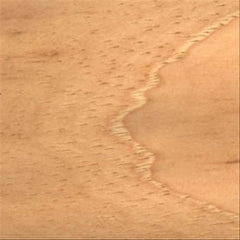

Flat Sawn

Quarter Sawn

End Grain
General Information:
Pecan can vary quite a bit in color. Certain varieties of hickory will contain off-white to tan colored sapwood, and dark reddish brown heartwood, while other varieties have off-white colored heartwood and sapwood. Small, dark brown specks or streaks occasionally are scattered throughout the wood. Pecan is closely related to hickory, and the lumber is often sold as hickory in lumber yards.
Common Name(s):
Pecan
Density:
45 lb/ft3 - Medium-high density
Hardness:
1800 lbft - Hard
Specific Gravity:
0.65
Turning Properties:
Pecan is moderately hard, and can be somewhat difficult to cut even when green. Sharp tools are necessary at all times. End grain tearout is very minimal when cutting across areas of end grain.
Drying Properties:
Pecan requires slower drying than many other hardwood species, as it has a definite tendency to develop surface checks and cracks during the drying process. It is recommended that drying rates be slowed to reduce the chances that this issue will arise. This can be achieved by wrapping additional layers of kraft paper around the roughed out turning, or by adding wet shavings around the container in which the piece is drying, and changing out the shavings every few weeks, as they begin to dry out.
Sanding Properties:
Sands well. For removing tool marks, 80 grit sandpaper is recommended. Will sand to a high luster, usually requiring grits no higher than 600 to achieve satisfactory results.
Finishing Properties:
Readily accepts most stains and finishes.
Toxicity
No known toxicities exist for this wood.
Turning with Sharp Tools - Scrapers
Last month, we began a new series of tutorials which will be covering the proper sharpening of lathe tools. In the introduction tutorial in that newsletter, we covered the proper ways of identifying dull lathe tools. This month, we're going to explain the proper method for sharpening scrapers.
When to Sharpen -
Scrapers should be sharpened as soon as they begin to produce dust, rather than smooth ribbons of wood while cutting.
Correct Sharpening Angle -
The proper sharpening angle for a scraper ranges from about 70 - 80 degrees, with the mid-range angle of 75 degrees being the best for most situations. Lower angles are better for cutting softer woods, and higher angles do better for cutting harder or more highly figured woods.

Burrs and How They Affect Scrapers -
After grinding, a slight burr will develop along the cutting edge of the scraper. With scrapers (unlike most other turning tools), this burr greatly affects the performance of the tool. There are three methods of dealing with this burr, and each will cause the tool to perform differently.
- Method #1: Leave the burr intact
By not removing the burr, you will cause the tool to cut more aggressively. This is useful when a large amount of material needs to be removed, but also increases the likelihood that catches may occur, increases the severity of end grain tearout, and increases the frequency with which you'll have to sharpen the tool. - Method #2: Reduce the burr
To reduce the burr, use a sharpening stone or diamond file to flatten the top edge of the tool after sharpening. After flattening the top face, hold the stone or file 90 degrees to the top face, and make a few very light passes to remove a portion of the burr. By removing part of the burr, you'll slow the cutting action of the tool slightly, but will reduce the likelihood of catches, reduce end grain tearout, and reduce the frequency with which you'll have to sharpen the tool. - Method #3: Remove the burr
To remove the burr, use a sharpening stone or diamond file to flatten the top edge of the tool after sharpening. After flattening the top face, hold the stone or file so that it rests on both the cutting edge and heel of the bevel at the same time. Make several light passes , until the burr is totally removed. By doing this, you'll greatly slow the cutting action of the tool, but you'll also have a tool that isn't likely to catch, can produce a very cleanly cut surface (especially when used for shear scraping), and won't need to be sharpened nearly as often.
All archived monthly newsletters do not include the following:
- Business updates
- Recently added woods and schedule of upcoming woods
- Photo of the month contest results
- Discounts and upcoming sales information
